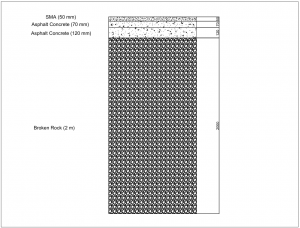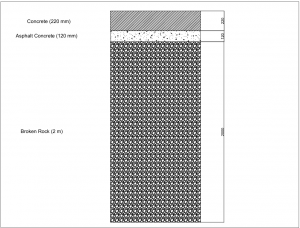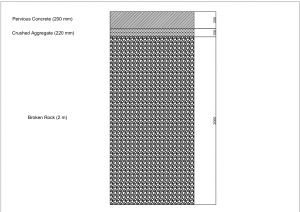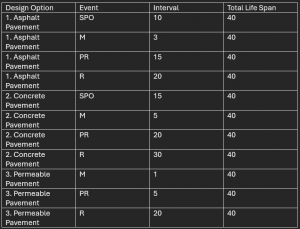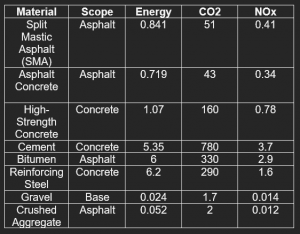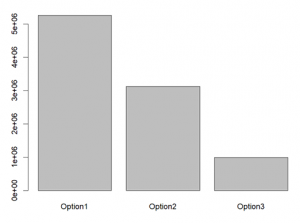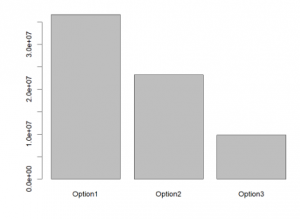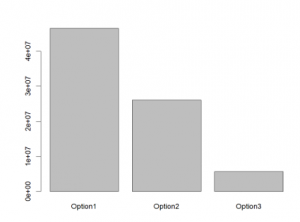Scope and Goal
This study compares the life cycle assessment of three design options for highway pavement systems: concrete pavement, asphalt pavement, and permeable concrete pavement. Each pavement design has specific material compositions, structural qualities, and environmental consequences that determine its durability over time. The analysis considers a 40-year lifespan, integrating aspects like energy usage and greenhouse gas emissions. The scope of this study includes the stages from the raw material extraction, processing, and production to the operation and maintenance of the pavement system during its life cycle.
Pavement Design Options
1. Asphalt Pavement (Option 1)
A flexible pavement with a 50 mm SMA surface layer, 70 mm + 120 mm asphalt concrete binder layers, and a 2 m broken rock base, offering cost-effective construction and ease of maintenance.
Figure 1: Design Option 1
2. Concrete Pavement (Option 2)
A rigid pavement with a 220 mm concrete surface layer, 120 mm asphalt concrete binding layer, and 2 m broken rock base, providing high durability and long service life.
Figure 2: Design Option 2
3. Permeable Pavement (Option 3)
A sustainable design option with a 200 mm pervious concrete surface, 100 mm crushed aggregate binding layer, and 2 m broken rock base, promoting water infiltration and reducing runoff.
Figure 3: Design Option 3
Lifecycle Timeline
The asphalt pavement requires regular maintenance every three years, shallow overlays every ten years, partial replacement every fifteen years, and complete replacement every twenty years. Concrete pavement has a longer lifespan, requiring maintenance every 5 years, overlays every 15 years, partial replacement every 20 years, and complete replacement every 30 years. The permeable pavement requires regular maintenance annually, partial replacement every 5 years, and complete replacement after 20 years. Overall, concrete pavement has the longest lifespan, whereas asphalt and permeable pavements require more regular maintenance.
Figure 4: Lifecycle Timeline with Interventions
SPO = Shallow Pavement Overlay
M = Maintenance
PR = Partial Replacement
R = Replacement
Lifecycle Inventory
The functional unit in this study is specified as 1 km of highway pavement with a total width of 8.5 m, comprising a 1 m inner shoulder and two lanes, each of which is 3.75 m wide. Energy consumption is measured in MJ/kg and gases in g/kg.
Figure 5: Life Cycle Inventory
LCA Results
The Life Cycle Analysis results show that asphalt pavement (Option 1) has the highest energy consumption and greenhouse gas emissions (CO2 and NOx), mostly due to regular maintenance activities that result in increased material and energy consumption. Secondly, concrete pavement (Option 2) has moderate environmental impacts with high initial emissions during the construction phase but lower long-term effects due to its durability and lower maintenance requirements. Lastly, permeable pavement (alternative 3) is the most sustainable alternative, with the lowest energy use and emissions, because it eliminates asphalt-related consequences and uses fewer high-emission materials, despite the need for more regular maintenance.
Figure 6: Energy Consumption
Figure 7: CO2 Emissions
Figure 8: NOx Emissions
